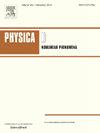Oscillatory instabilities in dynamically active signaling compartments coupled via bulk diffusion in a 3-D spherical domain
IF 2.7
3区 数学
Q1 MATHEMATICS, APPLIED
引用次数: 0
Abstract
For a coupled cell-bulk ODE-PDE model in a 3-D spherical domain, we analyze oscillatory dynamics in spatially segregated dynamically active signaling compartments that are coupled through a passive extracellular bulk diffusion field. Within the confining spherical domain, the signaling compartments are a collection of small spheres of a common radius . In our cell-bulk model, each cell secretes a signaling chemical into the extracellular bulk region, while also receiving a chemical feedback that is produced by all the other cells. This secretion and global feedback of chemical into the cells is regulated by permeability parameters on the cell membrane. In the near well-mixed limit corresponding to a large bulk diffusivity , where , the method of matched asymptotic expansions is used to reduce the cell-bulk model to a novel nonlinear ODE system for the intracellular concentrations and the spatially averaged bulk diffusion field. The novelty in this ODE system, as compared to the type of ODE system that typically is studied in the well-mixed limit, is that it involves and an correction term that incorporates the spatial configuration of the signaling compartments. For the case of Sel’kov intracellular kinetics, this new ODE system is used to study Hopf bifurcations that are triggered by the global coupling. In addition, the Kuramoto order parameter is used to study phase synchronization for the leading-order ODE system for a heterogeneous population of cells where some fraction of the cells have a random reaction-kinetic parameter. For a small collection of six cells, the spatial configuration of cells is also shown to influence both quorum-sensing behavior and diffusion-mediated communication that lead to synchronous intracellular oscillations. Moreover, we show that a single additional pacemaker cell can trigger intracellular oscillations in the other six cells, which otherwise would not occur. Finally, for the non well-mixed regime where , we use asymptotic analysis in the limit to derive a new integro-differential ODE system for the intracellular dynamics.
求助全文
约1分钟内获得全文
求助全文
来源期刊

Physica D: Nonlinear Phenomena
物理-物理:数学物理
CiteScore
7.30
自引率
7.50%
发文量
213
审稿时长
65 days
期刊介绍:
Physica D (Nonlinear Phenomena) publishes research and review articles reporting on experimental and theoretical works, techniques and ideas that advance the understanding of nonlinear phenomena. Topics encompass wave motion in physical, chemical and biological systems; physical or biological phenomena governed by nonlinear field equations, including hydrodynamics and turbulence; pattern formation and cooperative phenomena; instability, bifurcations, chaos, and space-time disorder; integrable/Hamiltonian systems; asymptotic analysis and, more generally, mathematical methods for nonlinear systems.
 求助内容:
求助内容: 应助结果提醒方式:
应助结果提醒方式:


